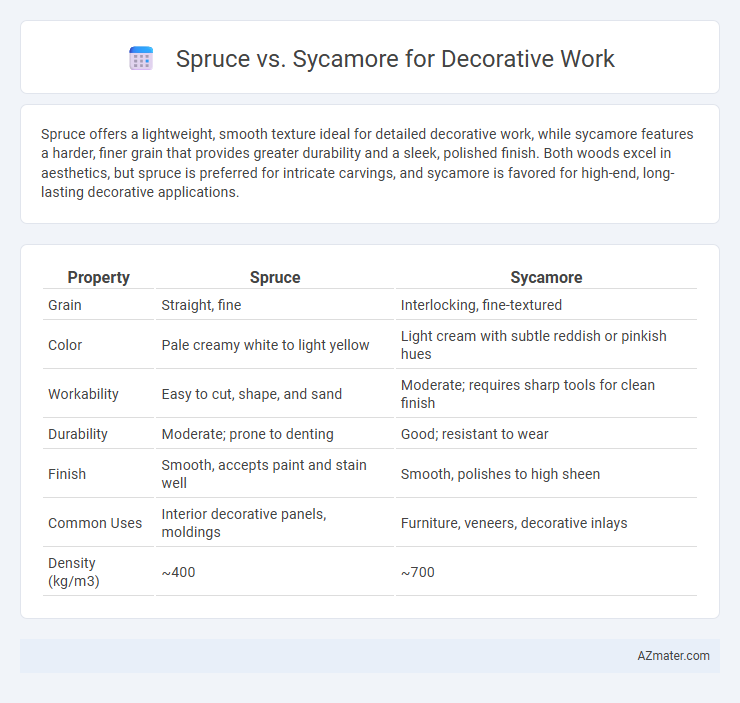Spruce offers a lightweight, smooth texture ideal for detailed decorative work, while sycamore features a harder, finer grain that provides greater durability and a sleek, polished finish. Both woods excel in aesthetics, but spruce is preferred for intricate carvings, and sycamore is favored for high-end, long-lasting decorative applications.
Table of Comparison
| Property | Spruce | Sycamore |
|---|---|---|
| Grain | Straight, fine | Interlocking, fine-textured |
| Color | Pale creamy white to light yellow | Light cream with subtle reddish or pinkish hues |
| Workability | Easy to cut, shape, and sand | Moderate; requires sharp tools for clean finish |
| Durability | Moderate; prone to denting | Good; resistant to wear |
| Finish | Smooth, accepts paint and stain well | Smooth, polishes to high sheen |
| Common Uses | Interior decorative panels, moldings | Furniture, veneers, decorative inlays |
| Density (kg/m3) | ~400 | ~700 |
Introduction to Spruce and Sycamore in Decorative Work
Spruce and sycamore are popular choices in decorative woodworking due to their distinct grain patterns and workability. Spruce offers a light, straight grain with a pale color, making it ideal for painted finishes and intricate carvings, while sycamore boasts a creamy, fine texture with subtle figure variations that enhance natural wood aesthetics. Both woods provide durability and versatility, but spruce is often preferred for structural decorative elements, whereas sycamore excels in fine furniture and artistic veneers.
Botanical Overview: Spruce vs Sycamore
Spruce (genus Picea) is a coniferous evergreen tree known for its needle-like leaves and softwood commonly used in musical instruments and construction; it thrives in cold, temperate regions and features a straight grain ideal for detailed carving. Sycamore (genus Platanus) is a deciduous hardwood tree characterized by broad, lobed leaves and a distinctive mottled bark, native to temperate North America and Europe, favored for furniture and decorative veneers due to its fine grain and light color. The botanical differences between spruce's softwood and sycamore's hardwood impact their suitability for decorative work, with spruce offering lightness and carve-ability, while sycamore provides durability and intricate grain patterns.
Appearance and Grain Differences
Spruce features a pale color with a subtle yellowish or creamy hue, showcasing a straight, fine grain that provides a smooth, consistent texture ideal for decorative work. Sycamore exhibits a more varied appearance, often displaying a creamy white to light reddish-brown color with distinctive, swirling, or mottled grain patterns that add visual interest and character. The contrast between spruce's uniformity and sycamore's pronounced figure allows craftsmen to choose based on whether a subdued or eye-catching aesthetic is desired for decorative applications.
Workability and Ease of Shaping
Spruce offers superior workability and ease of shaping due to its soft texture and consistent grain, making it ideal for intricate decorative work and detailed carving. Sycamore, while harder and denser, provides a smooth finish but requires more effort and specialized tools for shaping and fine detailing. Choosing spruce can reduce labor time and improve precision in decorative projects, whereas sycamore delivers durability with a limit on intricate shaping speed.
Strength and Durability Comparison
Spruce offers a lightweight structure with moderate strength, making it suitable for decorative work that does not demand high durability. Sycamore exhibits greater hardness and resistance to wear, providing enhanced durability and a longer lifespan for decor elements exposed to frequent handling. Choosing sycamore ensures superior structural integrity and resilience, while spruce remains preferable for projects requiring ease of carving and a softer finish.
Finishing Qualities: Stain and Paint Performance
Spruce offers a smooth surface with consistent grain, making it ideal for paint application as it absorbs finishes evenly and resists blotching. Sycamore features a finer, more uniform texture that takes stain exceptionally well, enhancing its natural figure and providing a rich, lustrous appearance. Both woods respond well to finishing, but spruce's lighter color and texture favor painted decorative work, while sycamore's vibrant grain is better highlighted through staining.
Cost and Availability for Decorative Projects
Spruce offers a cost-effective option for decorative projects due to its wide availability and lower price point compared to sycamore. Sycamore, while aesthetically attractive with its fine grain and pale color, tends to be more expensive and less readily available in many regions. For budget-conscious decorative work, spruce provides a practical balance of affordability and accessibility without sacrificing basic visual appeal.
Common Uses in Decorative Applications
Spruce is prized for its lightweight and fine grain, making it ideal for intricate carvings, musical instrument soundboards, and ornamental moldings. Sycamore features a distinctive grain pattern and durability, commonly used in high-end furniture, veneers, and decorative paneling to create visually striking surfaces. Both woods offer unique aesthetics, with spruce providing a softer, pale finish and sycamore showcasing a varied, figured appearance suited for statement pieces in interior design.
Environmental Impact and Sustainability
Spruce, known for its fast growth and high carbon sequestration rate, offers a lower environmental impact due to efficient reforestation practices and renewable sourcing. Sycamore, while slower-growing, provides long-lasting durability that reduces the frequency of replacement, contributing to sustainable use of resources. Choosing FSC-certified spruce or sycamore enhances sustainability by promoting responsible forest management and minimizing ecological footprints in decorative woodworking.
Choosing the Best Wood for Your Decorative Project
Spruce offers a lightweight, pale tone with a fine, even grain ideal for detailed carving and painted finishes, making it perfect for delicate decorative projects. Sycamore features a harder texture and distinctive, wavy grain patterns that provide a unique visual appeal and durability, suited for bold, statement pieces. Choosing between spruce and sycamore depends on the need for softness and ease of work versus strength and natural grain emphasis in your decorative application.

Infographic: Spruce vs Sycamore for Decorative Work
 azmater.com
azmater.com